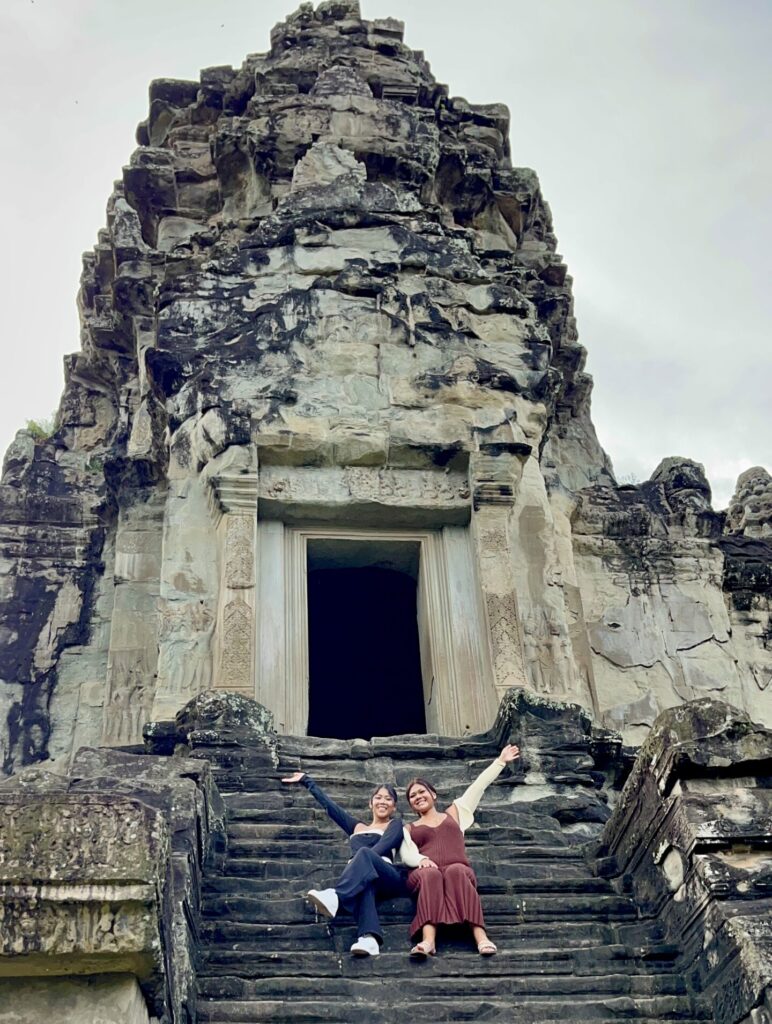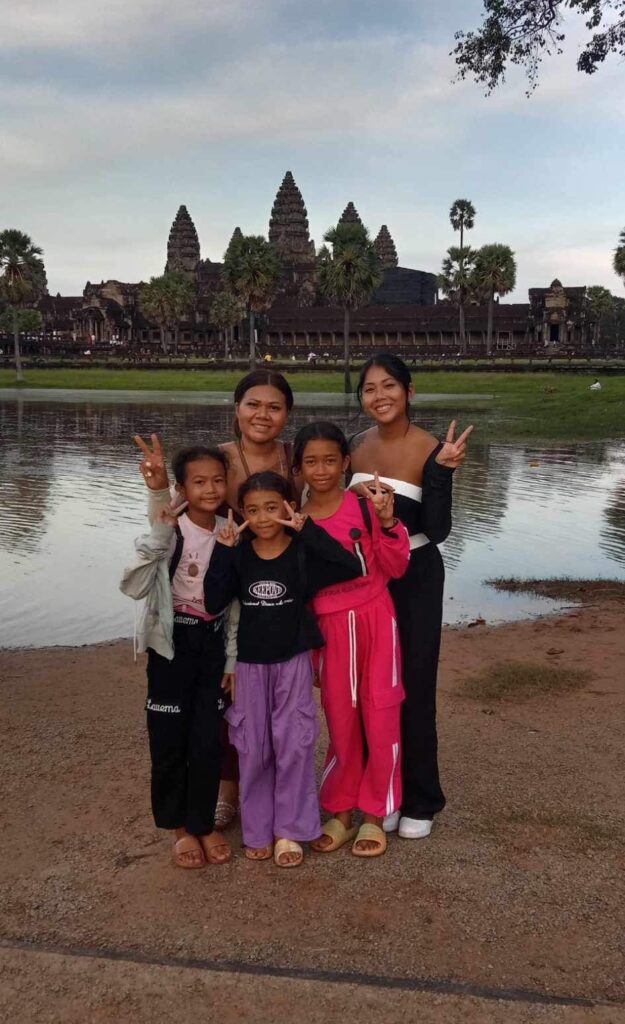March 27, 2024 IN: Our Voices, Staff Blog
Rediscovering and reclaiming my roots as koun Khmer
By Nary Rath
Content Warning: Mention of genocide, war, and violence
Last year, I visited Cambodia for the first time alongside my mother, who has not been back since she fled her home over 40 years ago. Visiting Siem Reap felt like a dream realized– I had to rub my eyes to make sure that I wasn’t imagining the vibrant colors and sounds around me. Throughout my life, I felt a strong pull from the universe telling me I needed to go to my ancestral homeland. Now finally setting foot on Cambodian soil, I felt a deep confidence that I was exactly where I was meant to be.

Nary and her cousin exploring Angkor Wat. Photo courtesy of Nary Rath.
During our trip, my mom, cousin, and I were determined to see the temples of Angkor Wat, an ancient religious complex in Cambodia and the largest religious monument in the world. As we approached the temple, the scene was bustling with motorcyclists speeding through the grand arch entryways, monkeys sprawling and begging tourists for a snack, and the sound of locals speaking my native language, Khmer. After winding through the lively roads, we parked our tuk tuk about a mile away from Angkor Wat and walked amongst the hundreds of locals that crowded the streets leading up to the temples. My cousin guided us through the maze of motorcycles, vans, tuk tuks, and bicycles. Families enjoyed meals on the side of the road together and children ran around barefoot with giant smiles on their faces. Anxiously peering my head through the crowd, I strained to catch a glimpse of the famous Angkor Wat. Locals stared us down as we walked towards the temples, our demeanor giving us away as visitors. We were even stopped by the police and asked to show our passports because we looked so out of place.
Finally, we made it through the deep forest and arrived at the massive and beautiful structure known as Angkor wat. The air had a sense of magic to it, as if you could feel the immense weight of history that surrounded us. We explored the ruins, taking in the etchings carved into the walls of gorgeous Apsara dancers and warriors. We saw figures of Buddhist monks that were destroyed and beheaded during the Khmer Rouge regime.
From war to genocide, Angkor Wat has withstood the test of time and remained a reminder of how indestructible and strong willed my people are.

Nary and her family in front of Angkor Wat. Photo courtesy of Nary Rath.
To not only visit Angkor Wat, but also explore it so freely and openly awakened feelings of pride within myself – I have never felt more proud to be koun Khmer (child of Cambodia).
My journey in this lifetime starts long before I was born. It begins with my family’s story in Southeast Asia, surviving war, genocide, and then resettlement into the United States. My mother grew up in a village in Battambang, Cambodia. She was one of ten siblings and her parents were farmers. She was only a child when Pol Pot’s regime violently took over her village. My mother was separated from her family for three years and was forced into child labor. She would tell me stories of working from dawn to dusk in the rice paddy fields with only one small bowl of rice to eat a day, which she had to share with the other children forced to work. Hearing gunshots, witnessing mass murder, and experiencing abuse were commonplace. Like many children of refugees, some history of what occurred during the genocide is lost due to our parents not wanting to recall these traumatic memories. After the fall of the Khmer Rouge regime, my mother was reunited with her family and they were relocated to a Thai refugee camp.
In 1983, my mother and her family were sponsored to come to the United States and they resettled in Ohio where they faced a multitude of unexpected challenges due to a lack of culturally competent and linguistic support in their community. My mom attended high school for only a few months but due to daily racism and xenophobia, she dropped out of school to work full time at a hotel cleaning rooms. My mom then relocated to Connecticut for more economic opportunity. She became the first woman in my family to own a home, where she raised my sister and I single handedly in a society where the odds were stacked against her.
Growing up as a child of refugees, I constantly dealt with the confusion of the duality of my identity. On one hand, I was American; I possessed the innate privileges that come with that status. Those privileges were being able to go to school, learn English, and live in a comfortable home without the fear of going hungry or living in a war torn country. On the other hand, I knew my family was different– my mom couldn’t speak English and people hated her for it and expressed their disdain for her through racist acts. We lived in a poor and under-resourced neighborhood where I was surrounded by unhoused folks, sex workers, and those struggling with substance abuse disorders. I did not understand the history of my family’s resettlement into the United States until my own curiosity and research led me to learn about the Cambodian genocide. Discovering the truth about who I am was just the beginning in becoming proud of my heritage. For a long time, I internalized the racism my family and I faced and I was ashamed of who I was.
Now, I know that the dark history of my family’s past serves as a testament to the strength and resilience that runs in my DNA. Those feelings were affirmed tenfold after visiting Angkor Wat and experiencing the spirit of perseverance and power that symbolizes my people. It has been a long, tearful journey but worth it now that I continuously celebrate and can relish in my identity as koun Khmer.
Nary Rath is SEARAC’s California Program Manager and can be reached at nary@searac.org





